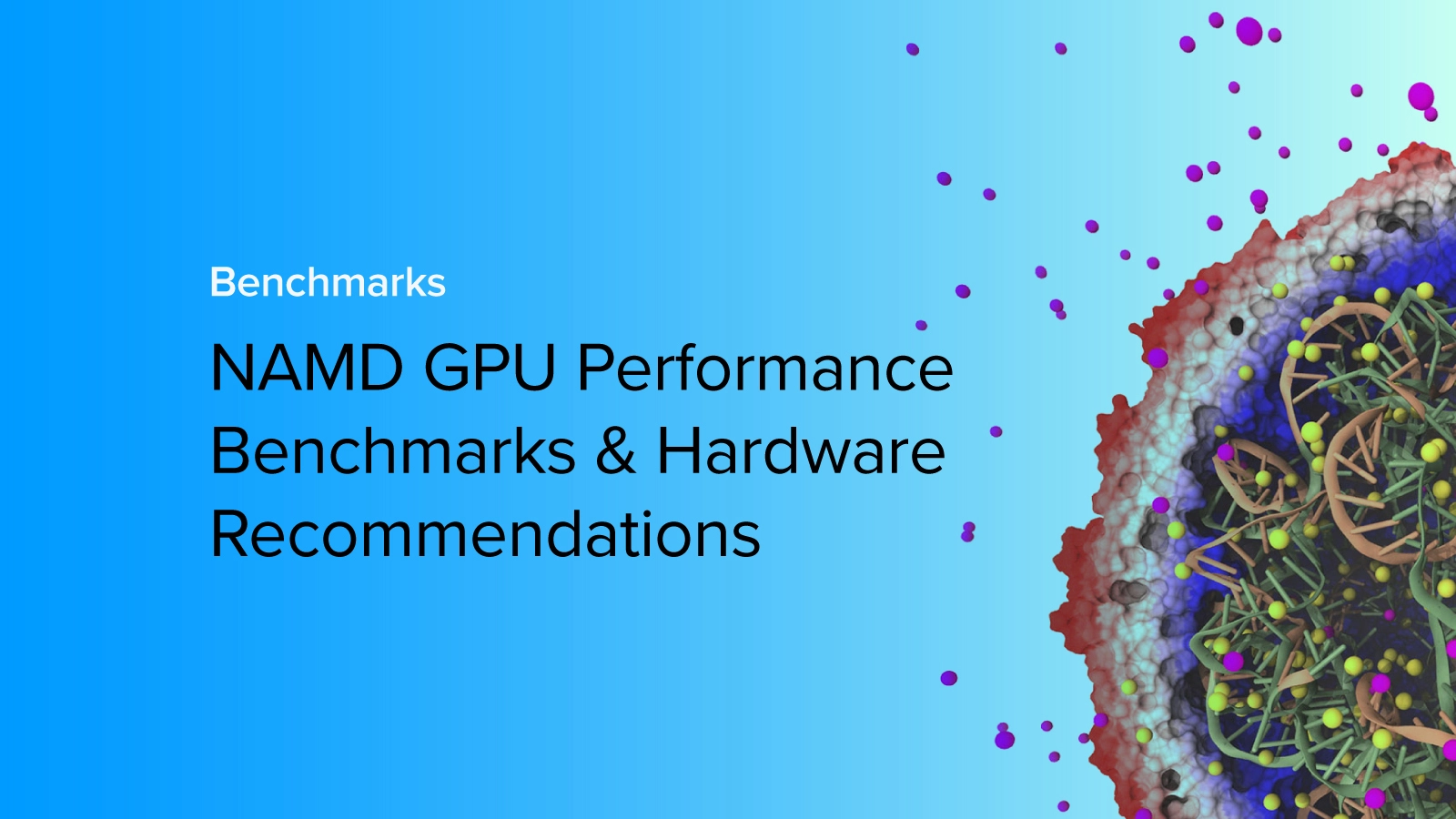
Update 4-17-24: Added 1x, 2x, 4x GPU Benchmark on Intel W9-3495X
7-13-23: First Uploaded
NAMD Benchmark Overview
As a value-added supplier of scientific workstations and servers, Exxact regularly provides reference benchmarks in various GPU configurations to guide Molecular Dynamics scientists looking to procure systems optimized for their research. In this blog, we benchmark the various CPU and GPU configurations to evaluate performance in NAMD and evaluate the total nanoseconds of simulation performed per day.
What is NAMD?
NAMD, or Nanoscale Molecular Dynamics, is a powerful and widely used molecular dynamics simulation program designed to study the behavior of biological systems at the atomic and molecular levels, providing valuable insights into their structure, dynamics, and interactions. NAMD utilizes a parallel computing approach, making it highly scalable and capable of simulating systems with astronomical sizes. Its ability to handle large-scale systems, efficient parallelization, and extensive range of simulation techniques make it an invaluable resource for researchers studying the behavior and properties of biomolecules at the atomic level.
Exxact Benchmark System Specifications
| Xeon W Workstation | Xeon Scalable Server | Threadripper PRO Workstation | |
|---|---|---|---|
| Processor | Intel Xeon W9-3495X | Dual Intel Xeon Scalable 8490H | AMD Threadripper PRO 5995WX |
| Total Cores | 56 Cores | 120 Cores (60 Each) | 64 Cores |
| Base/Max Boost Clock | 1.9GHz/4.8GHz | 1.9GHz/3.5GHz | 2.7GHz/4.5GHz |
| Memory | 512GB DDR5 ECC | 512GB DDR5 ECC | 512GB DDR5 ECC |
| Storage #1 | 1.92TB M.2 NVMe SSD | 4.09TB M.2 NVMe SSD | 4.09TB M.2 NVMe SSD |
| CUDA Version | 12.0 | 12.0 | 12.0 |
Components are the same if not highly similar to limit variability between tests.
Performance Benchmarks for NAMD
In the first test, we wanted to see if more CPU cores would contribute to better performance. Performance of NAMD on a single processor setup and a dual processor setup with the recently released NVIDIA RTX 6000 Ada. Dual Intel Xeon Scalable 8490H performs lower in this benchmark versus the single Xeon W9-3945X setup. The Intel Xeon Scalable 8490H has significantly more cores that could lend to an increase in parallel computing but we suspect that the interconnect between the dual CPUs affects performance slightly.

Next, we benchmark multiple GPU configurations on the Intel Xeon W9-3490H workstation CPU. As expected, the RTX 6000 Ada performance is the highest of the bunch. However, perfect scaling up to 4x GPUs on a 456K atom Her1-Her1 membrane simulation may not be apparent. Results may vary with larger simulations.

We also measured the performance of various GPUs in the single GPU configuration to test the speeds and find the best performance for the value. We will take the current NVIDIA Ada Generation GPU MSRP and the last generation Ampere GPU current average pricing (since the A5500 and A4500 did not ship with an MSRP).
.svg?format=webp)
RTX 4090 and RTX 4080 are tested on an AMD Threadripper PRO 5995WX processor since these two GPUs cannot scale past 2 GPUs per workstation whereas the RTX 6000 Ada, RTX A5500, and RTX A4500, tested on Intel Xeon W9-3945X can scale to 4 GPUs per workstation or up to 10 GPUs in a server. RTX 4090 and 4080 are consumer GeForce RTX graphics cards designed for gaming with high clocks speeds and high-power requirements, whereas the other three professional RTX GPUs in this test are designed for stability and scalability with ECC VRAM, stable clock speeds, and reasonable power requirements.
| GPU | ns/day | MSRP | Performance per Dollar (higher is better) |
|---|---|---|---|
| RTX 6000 Ada | 21.21 | $6800 | 0.003 |
| RTX A5500 | 16.39 | $2500 | 0.0065 |
| RTX A4500 | 13.00 | $1000 | 0.013 |
| RTX 4090* | 19.87 | $1599 | 0.012 |
| RTX 4080* | 19.82 | $1200 | 0.0165 |
From the results, the RTX 6000 Ada is the fastest of the lot with the gaming cards trailing right behind it. We also tested an NVIDIA H100 PCIe, but the results (17.06 ns/day) were a touch above the RTX A5500, not worth the $30,000+ cost for just running NAMD simulations.
CPU and GPU Hardware Recommendations for NAMD 2.14
We recommend sticking with single CPU configurations to avoid bottlenecks across a dual CPU interconnection that can skew results. In addition, a single CPU configuration incurs less cost than the more complex dual CPU setup.
For GPU recommendations for NAMD, there are different scenarios you may fall into. For those with a high budget and are looking to peak speed, the RTX 6000 Ada is a great GPU and delivers faster time to result than the other GPUs we tested. The best performance comes at a higher cost. These GPUs are suitable for NAMD and other molecular dynamics software suites as well as accelerating AI training.
If you have a medium to lower budget, we recommend a workstation with 4x RTX A4500, a popular accelerator for Life Science research. It may have the lowest performance and a last-generation GPU, but it has the best performance per dollar and has a high degree of scalability. Many opt for multiple 4x GPU 2U servers to populate their rack to run numerous simulations in parallel for research such as drug discovery.
If scalability is not a priority and portability of deployment is a must, a workstation with single or dual NVIDIA RTX 4090 or RTX 4080 is great for small-scale research in the lab. The performance is very good for the cost. However, if budget permits, opt for a quad RTX A4500 setup for more overall performance.
Closing Remarks
Not all use cases are the same and NAMD is most likely not the only application used in your research. At Exxact Corp., we strive to provide the resources in configuring the best custom system fit for you.
NAMD’s performance is not highly affected by the different setups, and you may benefit from optimizing your system to other more selective application requirements. While NAMD performance dropoff is noticeable in dual CPU configurations it is not drastic. Applications like GROMACS can benefit from additional cores and can be a tradeoff that can benefit workflows that predominantly use GROMACS.
If you have any questions about optimizing your system for NAMD or other molecular dynamics applications, our experienced engineers can help you along the way in configuring the perfect system fit for your application needs. Contact us today if you have any questions!

NAMD GPU Benchmarks and Hardware Recommendations
Update 4-17-24: Added 1x, 2x, 4x GPU Benchmark on Intel W9-3495X
7-13-23: First Uploaded
NAMD Benchmark Overview
As a value-added supplier of scientific workstations and servers, Exxact regularly provides reference benchmarks in various GPU configurations to guide Molecular Dynamics scientists looking to procure systems optimized for their research. In this blog, we benchmark the various CPU and GPU configurations to evaluate performance in NAMD and evaluate the total nanoseconds of simulation performed per day.
What is NAMD?
NAMD, or Nanoscale Molecular Dynamics, is a powerful and widely used molecular dynamics simulation program designed to study the behavior of biological systems at the atomic and molecular levels, providing valuable insights into their structure, dynamics, and interactions. NAMD utilizes a parallel computing approach, making it highly scalable and capable of simulating systems with astronomical sizes. Its ability to handle large-scale systems, efficient parallelization, and extensive range of simulation techniques make it an invaluable resource for researchers studying the behavior and properties of biomolecules at the atomic level.
Exxact Benchmark System Specifications
| Xeon W Workstation | Xeon Scalable Server | Threadripper PRO Workstation | |
|---|---|---|---|
| Processor | Intel Xeon W9-3495X | Dual Intel Xeon Scalable 8490H | AMD Threadripper PRO 5995WX |
| Total Cores | 56 Cores | 120 Cores (60 Each) | 64 Cores |
| Base/Max Boost Clock | 1.9GHz/4.8GHz | 1.9GHz/3.5GHz | 2.7GHz/4.5GHz |
| Memory | 512GB DDR5 ECC | 512GB DDR5 ECC | 512GB DDR5 ECC |
| Storage #1 | 1.92TB M.2 NVMe SSD | 4.09TB M.2 NVMe SSD | 4.09TB M.2 NVMe SSD |
| CUDA Version | 12.0 | 12.0 | 12.0 |
Components are the same if not highly similar to limit variability between tests.
Performance Benchmarks for NAMD
In the first test, we wanted to see if more CPU cores would contribute to better performance. Performance of NAMD on a single processor setup and a dual processor setup with the recently released NVIDIA RTX 6000 Ada. Dual Intel Xeon Scalable 8490H performs lower in this benchmark versus the single Xeon W9-3945X setup. The Intel Xeon Scalable 8490H has significantly more cores that could lend to an increase in parallel computing but we suspect that the interconnect between the dual CPUs affects performance slightly.

Next, we benchmark multiple GPU configurations on the Intel Xeon W9-3490H workstation CPU. As expected, the RTX 6000 Ada performance is the highest of the bunch. However, perfect scaling up to 4x GPUs on a 456K atom Her1-Her1 membrane simulation may not be apparent. Results may vary with larger simulations.

We also measured the performance of various GPUs in the single GPU configuration to test the speeds and find the best performance for the value. We will take the current NVIDIA Ada Generation GPU MSRP and the last generation Ampere GPU current average pricing (since the A5500 and A4500 did not ship with an MSRP).
.svg?format=webp)
RTX 4090 and RTX 4080 are tested on an AMD Threadripper PRO 5995WX processor since these two GPUs cannot scale past 2 GPUs per workstation whereas the RTX 6000 Ada, RTX A5500, and RTX A4500, tested on Intel Xeon W9-3945X can scale to 4 GPUs per workstation or up to 10 GPUs in a server. RTX 4090 and 4080 are consumer GeForce RTX graphics cards designed for gaming with high clocks speeds and high-power requirements, whereas the other three professional RTX GPUs in this test are designed for stability and scalability with ECC VRAM, stable clock speeds, and reasonable power requirements.
| GPU | ns/day | MSRP | Performance per Dollar (higher is better) |
|---|---|---|---|
| RTX 6000 Ada | 21.21 | $6800 | 0.003 |
| RTX A5500 | 16.39 | $2500 | 0.0065 |
| RTX A4500 | 13.00 | $1000 | 0.013 |
| RTX 4090* | 19.87 | $1599 | 0.012 |
| RTX 4080* | 19.82 | $1200 | 0.0165 |
From the results, the RTX 6000 Ada is the fastest of the lot with the gaming cards trailing right behind it. We also tested an NVIDIA H100 PCIe, but the results (17.06 ns/day) were a touch above the RTX A5500, not worth the $30,000+ cost for just running NAMD simulations.
CPU and GPU Hardware Recommendations for NAMD 2.14
We recommend sticking with single CPU configurations to avoid bottlenecks across a dual CPU interconnection that can skew results. In addition, a single CPU configuration incurs less cost than the more complex dual CPU setup.
For GPU recommendations for NAMD, there are different scenarios you may fall into. For those with a high budget and are looking to peak speed, the RTX 6000 Ada is a great GPU and delivers faster time to result than the other GPUs we tested. The best performance comes at a higher cost. These GPUs are suitable for NAMD and other molecular dynamics software suites as well as accelerating AI training.
If you have a medium to lower budget, we recommend a workstation with 4x RTX A4500, a popular accelerator for Life Science research. It may have the lowest performance and a last-generation GPU, but it has the best performance per dollar and has a high degree of scalability. Many opt for multiple 4x GPU 2U servers to populate their rack to run numerous simulations in parallel for research such as drug discovery.
If scalability is not a priority and portability of deployment is a must, a workstation with single or dual NVIDIA RTX 4090 or RTX 4080 is great for small-scale research in the lab. The performance is very good for the cost. However, if budget permits, opt for a quad RTX A4500 setup for more overall performance.
Closing Remarks
Not all use cases are the same and NAMD is most likely not the only application used in your research. At Exxact Corp., we strive to provide the resources in configuring the best custom system fit for you.
NAMD’s performance is not highly affected by the different setups, and you may benefit from optimizing your system to other more selective application requirements. While NAMD performance dropoff is noticeable in dual CPU configurations it is not drastic. Applications like GROMACS can benefit from additional cores and can be a tradeoff that can benefit workflows that predominantly use GROMACS.
If you have any questions about optimizing your system for NAMD or other molecular dynamics applications, our experienced engineers can help you along the way in configuring the perfect system fit for your application needs. Contact us today if you have any questions!



.jpg?format=webp)
